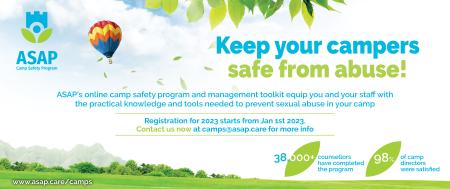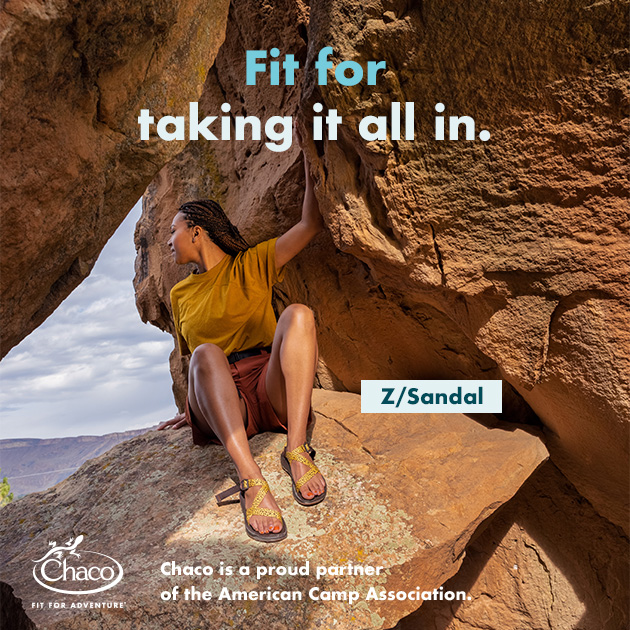In architecture, the phrase “form follows function” means that a building’s purpose should be the starting point for its design. Similarly, the purpose of camp staff — why you have them and what their roles are — should be the starting point for the strategic design of your staffing plan.
First and foremost, frontline camp staff’s primary function is to ensure continuous quality supervision of participants and mitigate risks so every camper has a safe and positive experience. Toward that end, staffing patterns should be designed to support specific staff roles and responsibilities in the areas of risk management, injury prevention, and participant safety. Take, for example, the establishment of your staff-to-participant ratio in a strategic form-follows-function staffing plan: you would first determine the staff control needed for both an activity and the clientele variables that impact the activity. Those factors will then determine the number of activity participants — rather than simply setting a number of participants and then staffing to meet that number.
Program assessment is a tool that you can use to identify the supervisory controls and skill sets required of staff in order to manage activity risks and to provide a framework for making informed staffing decisions.
Before conducting the assessment:
- Reach out to your camp’s insurance, legal, and human resources professionals to identify applicable local, state, and federal laws and regulations that give direction to how camp/activities must be conducted or staffed, and that ensure compliance with employment laws.
- Review any accreditation or organizational standards, policies, or other requirements. As applicable, make note of certifying bodies that have established limits for how many participants a certified individual is allowed to supervise.
- Review your camp’s accident, incident, and similar reports — ideally for the last several years. Note repeat issues and “near misses,” specifically those that indicate a need to conduct or supervise an activity/area differently. Reviewing parent/participant evaluations and complaints can also be useful.
During the assessment, include qualified individuals with a high level of experience in each of the activity areas whenever possible, including individuals from outside camp when there is no in-house expertise in a particular area. This is especially critical for activities that require specialized equipment or supervision, as well as high-risk activities or activities with extensive variables — such as horseback riding, high-ropes, aquatics areas, and off-site trips. Outside experts may also bring a fresh set of eyes and perspective to the review process — allowing for constructive criticism of current practices and ideas unfettered by “the way we have always done it” thinking.
Conducting the Assessment
You can utilize the assessment process to evaluate staffing needs for a single activity area or for your whole camp program. As applicable, include all activities where participants are (or should be) supervised by camp staff:
- Special events
- Camp-provided transportation
- Mealtimes
- Cabin/group times
- Trips
- Unstructured times
You can repeat the assessment for each operation type and/or different clientele served — such as rental programs, user groups, and educational programs.
STEP 1: Identify Activity Variables
For each program, activity, or area being reviewed, identify and list all possible variables that may impact how camp staff should supervise or conduct the program or activity. The purpose here is to identify all aspects of your program activities and areas that may pose a potential risk to participants or impact how an activity should be conducted or supervised. Then you can pinpoint what control measures staff must take to prevent accidents from occurring. When assessing activities, it is important to not focus only on possible worse-case scenarios; the end goal is to paint a comprehensive picture that includes all aspects. While each camp will need to assess based on its own specific activities, some examples to consider include:
- The inherent and known risks to participants
- Hazards, risks, or impacts due to/with the physical facility or location where the activity takes place
- Hazards, risks, or impacts due to/resulting from animals or program equipment utilized in the activity and how activity equipment is used, inspected, fitted, repaired, transported, and stored
- Physical security — vehicles, traffic, public access, campers intermingled with the public
- Anything that impacts the ability of staff to clearly see, hear, or communicate with participants
- Staff proximity to participants, which may impact supervision, accident prevention, or speed of response
- Anything that would impact, block, or delay staff from efficient emergency response
- Man-made hazards
- Anything that may impact the health or well-being of participants
- Access to safe drinking water and restroom facilities (or environmentally responsible alternatives)
- Access to shelter, including during inclement weather or an emergency
- Environmental hazards — plants, animals, insects, weather, water, terrain, altitude
- Weather/temperature for staff/participants — heat, cold, water temperatures
- Aquatics activities — anything that might make supervision, swimming, watercraft navigation, or rescue difficult, such as catch pools, play structures, tides, currents, or river hazards
- Anything that may create a need for or impact evacuation of campers and staff from an activity
- Access to first aid or emergency response — rescue equipment available; time to get to a participant in the event that rescue is required; evacuation, distance and time to/from EMS; communication access to EMS
- Factors in and causes of past accidents or incidents in an activity, including any information from the review of accident, incident, and similar reports
STEP 2: Identify Participant Variables
The participants themselves can greatly impact the ability to control an activity and also can affect emergency response. For each program, activity, or area being reviewed, identify and list all possible participant variables that may impact appropriate supervision or camp staff conduct. While each camp will need to assess based on specific clientele(s) served, here are some examples to consider:
- Participant age — may impact ability to follow instructions, attention span, and desire to learn
- Maturity of participants — may impact how a participant copes in an emergency or personal difficulty, approaches personal safety and risk-taking, and roles they may take in the event of emergency
- Physical ability and condition — may impact how a camper participates, the supervision required, types of accommodations required, personal safety (such as the need to “self-rescue”), or medical concerns requiring staff intervention
- Physical size — can impact the staff’s ability to respond in an emergency, number of staff required to execute a rescue, size/type of emergency equipment required, and size of program equipment required
- Mental ability — may impact supervision required, ability to recognize hazards, and ability to follow directions
- Skill level and experience of participants: — Are participants “never-evers” or experienced? Are they capable of self-rescue? What is their level of readiness for the activity? How are participants’ skills assessed?
STEP 3. Define Controls and Accident-Prevention Strategies
The more control staff have over the variables, the lower the risk of injury to participants.
Camps should next identify what type(s) of staff control and accident-prevention strategies need to be in place for each variable listed in Steps 1 and 2. The goal is to identify what staff need to be able to “take control of” in order to conduct the activity and prevent accidents from occurring.
In this step, camp operators determine variable controls, which specifically includes defining staff roles, responsibilities, actions, and required skills. For example, a lifeguard’s ability to prevent accidents decreases when their ability to see participants is disturbed for any reason (variable). When visibility is decreased, the lifeguard can implement accident-prevention strategies to increase control and lower participant risk. The lifeguard might:
- Move to a guard station with better visibility
- Restrict underwater swimming
- Increase the frequency of “buddy checks”
- Increase the number of guards on duty
- Change or close the activity
- Move participants to a different area
Again, while each camp’s needs will vary, some examples of actions in this step may include:
- Revising how an activity is conducted and identifying the circumstances that require changes to how, if, where, or when the activity is conducted
- Training staff in specific accident-prevention skills — such as being able to quickly identify when participants are struggling, how to recognize signs of distress, and how to maintain vigilant observation
- Types of decision-making that are and are not permitted by frontline staff and at what point supervisors or administrative staff should step in
- Proximity of staff to participants — the circumstances in which staff should change locations
- Staff-to-participant ratios — the circumstances in which the number of qualified staff should be increased to meet the needs of the specific participants and for safety reasons
- Reducing the number of participants
- Staff training to improve the staff’s ability to recognize and respond to potential hazards before they become an issue for emergency response
- Practices that improve staff’s ability to observe behaviors and hazards that can be stopped or modified to prevent injury — such as enforcing participant rules or how long staff are on-duty
- Creating job descriptions that include the cognitive and physical skills, knowledge, and capacity to recognize, address, and prevent actions that may put campers at risk
- Defining certifications and qualification requirements for staff
- Hiring/acceptance requirements, including such things as maturity and judgment, prior experience with the type(s) of activities to be conducted, etc.
- Clarifying when an activity must be modified to provide appropriate accommodations, such as when a participant requires one-on-one assistance, or anytime a participant is required to remain “within arm’s reach”
STEP 4. Emergency Response
The higher the quality of the response, the lower the risk of injury to participants.
Ideally, camp operators should emphasize control and prevention — rather than rescue and response — as the primary methods to prevent or reduce accidents and incidents. However, staff must also be able to effectively respond as needed. In this step you will put how the variables are to be controlled in place, which specifically includes defining roles, responsibilities, actions, and skills required of staff when responding to an accident or incident. Examples may include defining:
- Job descriptions that include cognitive and physical skills, knowledge, and capacity to recognize and respond to incidents and accidents
- Activity-specific Emergency Action Plans (EAP); staff roles, responsibilities, and actions within the EAP
- Where staff should be located and their proximity to participants
- Procedures and training to address security concerns or other identified variables when activities take place away from camp, when the public has access, or when campers are intermingled with the public
- Response/treatment equipment availability, use requirements, and training and practice in use
- Communication equipment availability, use requirements, and training and practice in use
- Training and practice of participant and staff evacuation from the activity
- Skills/physical ability to respond and execute rescue of the specific clientele(s) served, including participants with varying physical abilities, conditions, inability to self-rescue, or of a physical size that impacts the staff’s ability to respond in an emergency, the number of staff required to execute a rescue, or the size and type of emergency equipment required
- Activity conduct revising and the circumstances that require changes to how, if, where, and when the activity is conducted
- Response staff-to-participant ratios and the circumstances that require increasing ratios to execute rescue
- Certifications and qualification requirements for staff who respond to emergencies
- Hiring/acceptance requirements, including such things as maturity, judgment, and prior experience with the type(s) of activities to be conducted
- Contracting with resources outside of camp
STEP 5. Make Informed Staffing Plan
Use the information from the previous steps to make an informed staffing plan. After completing Steps 3 and 4, you should have a comprehensive list of strategies to help staff safely conduct each activity and prevent accidents from occurring.
While individual camps’ outcomes in how staffing decisions are informed will vary, some examples include establishing or modifying:
- Attributes, skills, abilities, and experience required for hiring or volunteer acceptance
- Types and levels of qualifications and certification required for the position
- Preservice and in-service training requirements
- Staff positions available (adding, deleting, or modifying roles)
- Policies and procedures to reduce, manage, and respond to the identified risks
- How staff conduct and supervise activities
- The types of decision-making permitted by frontline staff
- Staff-to-participant supervision ratios
- Job descriptions
Example:
During the assessment, Camp Happyfunshine identified that most campers are beginner swimmers who are not always comfortable in the water and fatigue easily. They also identified several items to be modified to increase the effectiveness of staff in accident prevention and determined their swimming lesson activities needed to be conducted and staffed differently. Their staffing plan now includes increasing the number of lifeguards on duty during swimming lessons, including positioning a roving guard on deck in more immediate proximity to the inexperienced swimmers. Additionally, they are lowering the number of participants in each swim group to increase staff-to-swimmer supervision ratios and allow for more individual instruction time. To support these efforts within their budget, for staff with relevant skills, they are going to cross-train swimming instructors and lifeguards to increase the number of available certified staff for teaching/guarding in each activity period. They are also outsourcing the maintenance of the pool to a local pool company, ensuring their trained staff stay focused on their teaching roles and safety of participants in the water, rather than being distracted by checking pool chemicals and cleaning duties. The camp counselor role now includes responsibilities to monitor the behavior of those campers who are not in the water. Additional in-service training will be added to improve staff readiness for responding to emergencies.
By using the information gained in the assessment process and focusing on the outcomes using the “form follows function” practice, you can design a staffing plan that is specific to your camp — specific to your programs and activities, specific to the type of facilities and environments utilized, and specific to the needs of your clientele.
Photo courtesy Sherwood Forest Summer Camp, McDade, TX.
Diane Tyrrell, MA Ed, CCD, has over 35 years professional experience working within the camp, youth development, and education fields with for-profit and nonprofit camps and organizations. Diane is the CEO of Frog Pond Consulting, providing integrated solutions to help meet ever-changing marketplace challenges for universities, private schools, camps, recreation, and nonprofit organizations. She also provides advisory and professional services for insurance and legal professionals. Reach her at [email protected].



